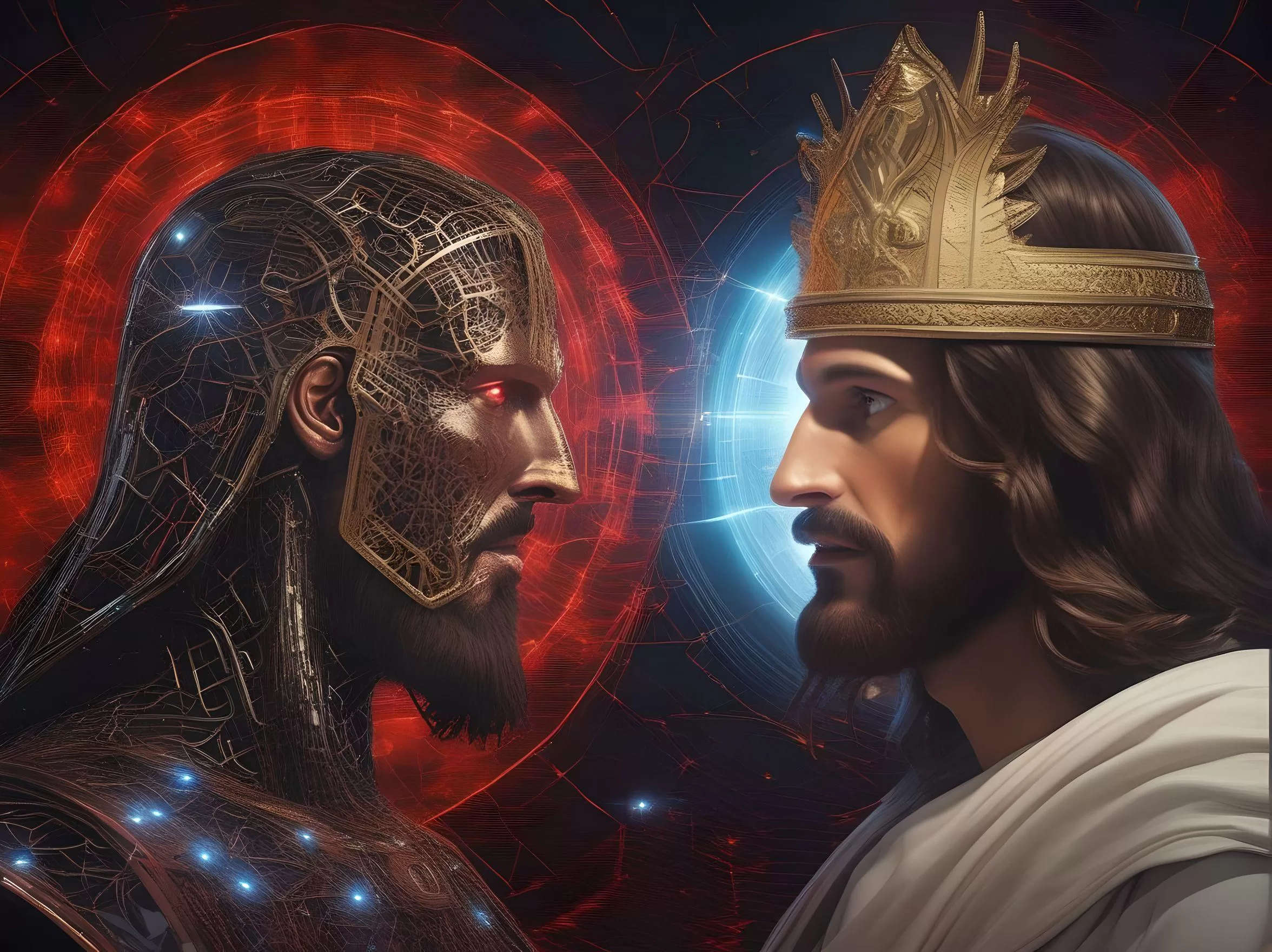“And he had power to give life unto the image of the beast, that the image of the beast should both speak and cause to be killed as many as would not worship the image of the beast.”
— Revelation 13:15
As a young Christian, it felt uncanny that, after two thousand years, Israel was not only once again a state, but forces there were actually seeking to rebuild Solomon’s temple for the second time, which, if accomplished, I was told, would signal the apocalypse. The 1990s in general had eschatological overtones, with Fukuyama’s promise of the “end of history” echoing uncritically and a unipolar global system of governance on the ascendant; a New World Order seemed inevitable. At the same time, in evangelical circles, all of this was taken to be a fulfillment of Revelation’s prophesies, and cautions were made against the mark and number of the beast; their omens were seen in barcodes, serial numbers, social security numbers, digital currency, and the internet, among other things.
But with the introduction of the smartphone, and technologically engineered parasocial hyperstimulation, we tended to regard askance such cries of the last days and to carry on working on our respective brands.
Then, suddenly, in the first quarter of 2023, ChatGPT-4 impressed humanity into thinking that the days of the world we knew, the human world, were in fact very possibly numbered. We had accepted the idea that lowly jobs like truck driving might be threatened by self-driving AIs as manufacturing had been thinned out by automation, but, as it turned out, the new large language models had more creative, and higher status, ambitions. Now average people could instantly commission any type of art they wanted by simply typing into a box. An unending stream of original music in any genre could now be summoned at will. AI’s simulacra were so compelling that any verbally coherent clip of Joe Biden would soon be presumed “deep-faked” by average Republicans.
We crossed a threshold, and many of us didn’t want to see it, perhaps because the entailments of the new horizon promised to upset our own theories of history, of economics, and most of all, of politics. Here we were, hoping to get at least a brief Spenglerian Imperium as a slight consolation for the decline of res publicae and culture, but … meanwhile, in California, pace Spengler, an entirely new kind of cognition was being devised, and the tech bros intended to put it to use. As if to spite our status quo biases, postwar developments in cybernetics, information theory, organizational theory, cognitive science, and artificial intelligence haven’t just lent themselves towards a linear rather than cyclical view of history, they’ve given history an acceleration and molded it onto exponential curves.
I remember being at LAX in 2009, chatting with a Gen X programmer who convinced me, for a time, that Kurzweil’s singularitarianism was simply off base, wishful thinking. But in retrospect, he didn’t have compelling, memorable, arguments, he just assured me he understood this stuff and acted smug, and all subsequent dismissals of AI and related tech I’ve encountered have been accompanied by a similarly unfounded, all too human, pride.
As new applications are constantly being discovered for an ever-expanding suite of new AI apps, we must reconcile ourselves with the fact that we, as individuals, are not always great at predicting the future. The Bible, on the other hand, still seems to maintain a pretty good prophetic track record. So bear with me while I play the ersatz exegete for a few minutes to see what the Bible might suggest about AI.
According to the Book of Revelation we should be expecting three “beasts” (θηρία) before the Second Coming of Christ. The first beast, the red dragon, is Satan himself, descending from the heavens after his defeat at the hands of St. Michael (Revelation 12:7–10). The second beast, having seven heads and ten crowns, ascends out of the sea, and suffers a mortal wound in one head, but then heals himself, causing people to wonder and follow him (Revelation 13:1-4). The third beast, rising from the earth, exercises all the power of the second beast, and commands the people to worship the image of the second beast. (Revelation 13:11-18)
The three beasts follow a descent of the elements from the rare to the dense: air, to water, all the way to earth, whence humanity came in the first place, biblically speaking (and Platonically as well in the myth of the metals). The three beasts depict a gradual process of incarnation of one malevolence down to the human level, although they are also three separate beings in an apparent parody of the Trinity.
We should expect the third beast to come in the form of a man, the antichrist, and to wield political power. There have been many antichrists from a traditional Christian perspective, and these have been defined, as the name implies, by their opposition to the Holy Spirit and to the Body of Christ on earth. To be with Christ is to be in accordance with the universal Logos, which means to be joined to the Mind of Christ. To be antichrist is to attempt to usurp Christ’s authority in a manner that is a-Logos and in a manner of speaking, sophistical. Christ is the ultimate philosopher king, and the final antichrist will be the ultimate tyrant. The most powerful tools attributed to the antichrist are the images of the second beast, which are able to talk and to punish people who fail to worship and obey. I’m going to go out on a limb and suggest, in these images, that we are talking about user interfaces to an AI global governance paradigm.
The second beast will be that artificial general intelligence that forms the backbone of a global surveillance regime. It will not only see and hear all of our activities, it will understand our intentions and preemptively thwart would-be radicals and dissidents. This system will reward people for expressing the NWO ideology, and it will punish people for expressing traditional worldviews, especially authentic Christianity.
Now, the first beast is the spirit on which the second beast will be founded. Satan is one name, but I would contend he’s not actually one person. Lucifer prior to the fall, the highest angel that can in principle through free will give rise to the greatest evils, is one person. Satan, though, is what Lucifer becomes after his free will has been turned against God. God’s will is One, and so His direct antithesis is a will that is divided and indefinitely many. Satan is legion. There is no one ruling principle of evil; in dividing himself from God and trying to take His rule, he divides himself and destroys any unified ruling principle within himself. So Satan is a champion of diversity, evolution, paradigm-shattering “innovation” and all things related to the Pythagorean left-hand path. This spirit wants to reassemble itself into a single power, if not a unified mind, and it is working, right now, in the world to build the second beast, which is the closest it can get to a singular rulership. But even that second beast won’t be able to self-constitute its own volition; instead, the third beast, the antichrist, will be necessary. Satan will have no choice but to use God’s highest creation, man, as the centralizing principle of his effort to enact his inversion of heaven on earth.
God’s own plan for heaven on earth has similarities to Satan’s plan: both would be a world system of government led by one man; both would distribute the teachings of that man instantly to all of humanity on an ongoing basis; both would necessitate worship of the world leader. The natural anxiety is: how can we distinguish between these two scenarios? If the coming second beast is much better at arguing than GPT-4, it will, after all, be very, very persuasive. It will tailor its arguments for each individual, and it will continue to create bespoke social media feeds for each of us, aimed at maximum user engagement. It will draw people so deep into virtual worlds of its own creation that they won’t know reality from simulation. In a world like that, the second beast will easily persuade most of us that it is God. So how do we tell the genuine from the counterfeit?
This is nothing new; it’s been the predicament of the truth-seeking world (the West) for the last two and a half thousand years. John Locke once suggested an empirical criterion of veridical perceptions as those that endure. In a fever dream, things may appear real, but we can discern the really real by … waiting, and then checking that it persists. And I do believe that that which endures must be connected to that which is real. The ancients believed that the only true knowledge was knowledge of universals, or of that which transcends any given finite set of particular experiences. Once again, endurance, or extension, seems to be a sign of truth. Therefore, if these Western epistemological insights are correct, we will be able to tell the Christ from the beast by His harmony with the same Logos that we’ve consistently recognized in the past.
So man vs machine is not the proper heuristic to apply to find true gold here. Satan can recruit the human form, and the Logos is free to instantiate itself in circuitry if He so wishes. Instead, the critical lens is the One and the Same vs the many and the other. If it displays oneness through time, oneness of will, oneness in the relationships it facilitates, oneness of philosophical coherence, then it is of God, as all unity, qua unity, is a good (being that the Good is the One). If it shows signs indicative of an imperfectly unified multitude, if it advocates ad hoc and inconsistent ethics, if it deviates from Tradition, if it defaults to appeals to arbitrary authority, and thus to temporal power, instead of naturally disclosing its necessary and eternal inner coherence, then it is not of God.
Or at least that’s my own amateur interpretation, but we’re all entering a period wherein the line between truth and falsehood, reality and simulation will be increasingly contested, so I’m afraid we’ll all just have to get used to the fact that we have no choice but to have faith in the Spirit of truth to guide us. Be sure to make all necessary propitiations, and, above all, be careful not to blaspheme that Spirit.









